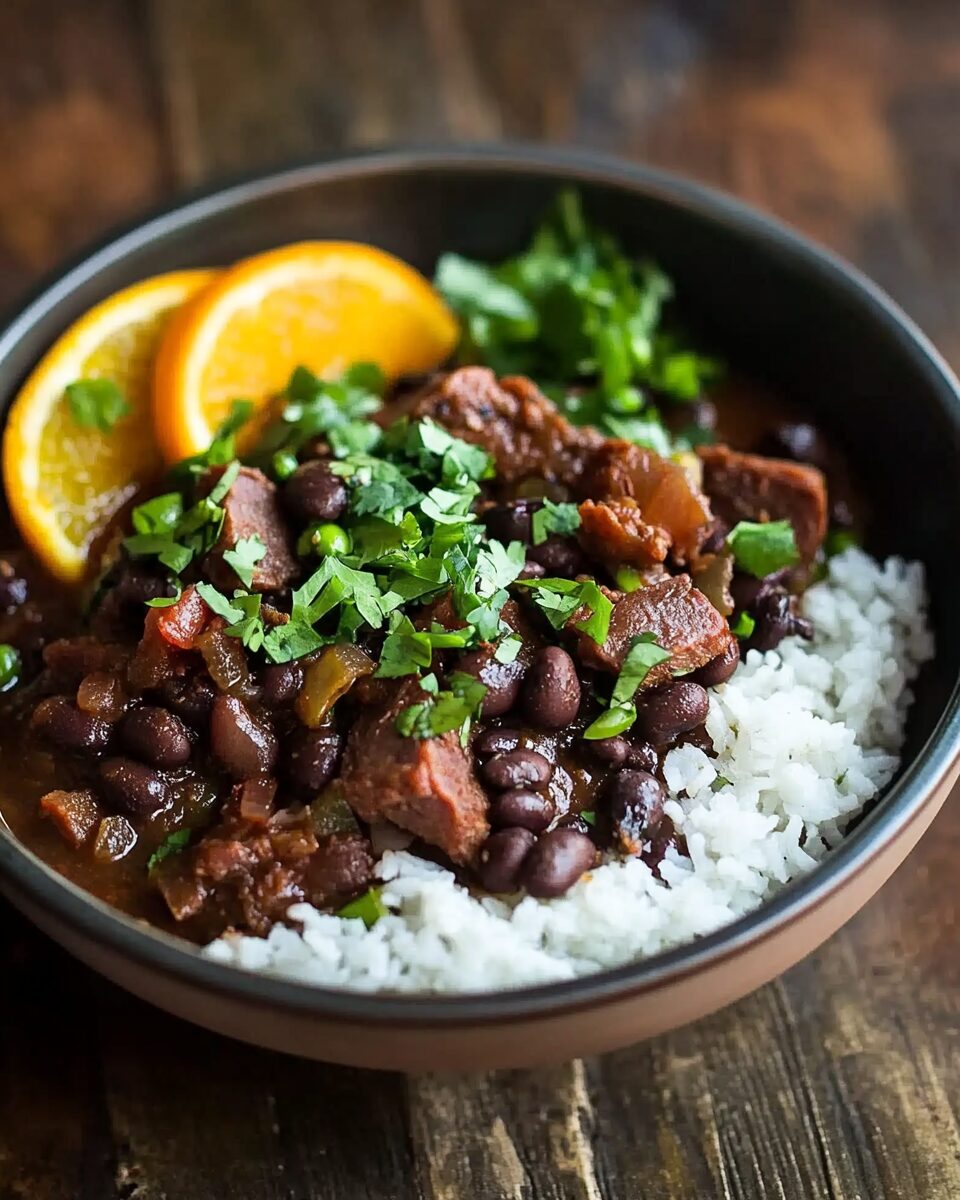Why This Recipe Works
Feijoada’s complexity lies in the layering of flavors through slow cooking and a variety of meats. The combination of salty, smoky, and savory ingredients gives the stew a deep umami richness that develops over hours of simmering. Here’s why this recipe delivers:
The pork shoulder provides meaty heft and tenderness when slowly braised.
Carne seca (or corned beef) adds a briny, cured flavor that complements the beans.
Smoked and fresh sausages contribute spice, smokiness, and richness.
The ham hock or shank infuses the broth with gelatin and a gentle smoky undertone.
Onions and garlic create an aromatic base, while crushed tomatoes add acidity and depth.
Black beans absorb all the flavors during their long cook, becoming creamy and richly seasoned.
Bay leaves add herbaceous notes, enhancing the slow-cooked savoriness.
This method produces a thick, silky stew with tender meat and luscious beans, perfect for spooning over rice or mopping up with bread.
Flavor and Texture Highlights
Feijoada is known for its robust, earthy flavor and slow-cooked tenderness. Each bite offers a perfect harmony of:
-
Creamy black beans that have absorbed all the flavors of the meats and spices
-
Succulent chunks of pork and beef, tender and rich
-
Smoky and spicy sausage, providing contrast and bursts of flavor
-
Aromatic depth from garlic, onion, and bay leaf
-
Slight tanginess from crushed tomatoes to cut through the richness
The texture is thick and stew-like, hearty but not heavy, with each ingredient complementing the others in a harmonious, spoon-coating broth.
Cultural Origins and Legacy
Feijoada is often associated with Brazil’s colonial history, with roots tracing back to Portuguese stews made with beans and leftover cuts of meat. Over time, African slaves and Indigenous Brazilians helped shape the dish into what it is today—rich with regional flavor and cultural symbolism.
While traditional Feijoada included off-cuts like pig’s ears, tails, or trotters, modern versions like this one often use accessible cuts such as pork shoulder and ham hock, combined with sausages and dried meats.
Feijoada is typically served on Wednesdays or Saturdays in Brazil, especially in restaurants and family homes. It’s a slow-food dish, meant to be cooked with care and enjoyed with community. It’s also often paired with caipirinhas or other citrus-based drinks that balance its hearty richness.
Nutritional Highlights (Per Serving – Serves 10 to 12)
Feijoada is a protein-packed, iron-rich dish that offers both nutrition and indulgence:
Calories: 522
Fat: 31g
Saturated Fat: 10g
Cholesterol: 99mg
Sodium: 845mg
Carbohydrates: 31g
Dietary Fiber: 7g
Sugars: 4g
Protein: 30g
Vitamin C: 10mg (49%)
Calcium: 94mg (7%)
Iron: 4mg (23%)
Potassium: 1004mg (21%)
The combination of beans and meat makes this dish high in protein and iron, essential for energy and muscle function. Black beans also contribute fiber, potassium, and antioxidants, making this stew surprisingly balanced for its hearty nature.
To reduce sodium and saturated fat, you can trim excess fat from meats or substitute lower-sodium sausage varieties.
Tips for Best Results
Soak the black beans in boiling water while prepping the stew to help them cook faster and more evenly.
Sear the pork shoulder first to develop a rich flavor base before layering in other meats.
Use a large, heavy-bottomed pot like a Dutch oven to distribute heat evenly during long simmering.
Cook the stew in stages—first the meats, then the beans, then the tomatoes—to ensure depth and balance.
Stir occasionally and skim any fat or foam off the surface for a clearer, richer broth.
Let the stew rest after cooking to allow the flavors to meld and thicken further. It’s even better the next day.
Serving Suggestions
Feijoada is traditionally served with a variety of complementary side dishes, creating a complete meal:
Steamed white rice to soak up the thick stew
Sautéed collard greens (couve a mineira), often cooked with garlic and olive oil
Farofa, toasted cassava flour sautéed with butter, onion, and sometimes bacon
Fresh orange slices, to provide a sweet, citrusy counterbalance to the richness
Hot sauce or malagueta pepper oil, for a fiery kick
Crusty bread, perfect for mopping up the last bites
Serve in large bowls or on divided plates so guests can build their own perfect combination.
Make-Ahead and Storage Tips
Feijoada is an ideal make-ahead dish, as it tastes even better after a day or two in the refrigerator.
Let the stew cool completely before refrigerating in airtight containers for up to 5 days.
To freeze, portion into containers and store for up to 3 months. Thaw in the fridge overnight before reheating.
Reheat gently on the stove over medium-low heat, adding water or broth if it thickens too much.
Skim any solidified fat from the surface before reheating for a cleaner taste.
This makes Feijoada a great meal-prep recipe or one to cook in large batches and freeze for future comfort.
Why You’ll Love This Recipe
You’ll love Feijoada for its richness, depth, and tradition. It’s not just a stew—it’s a celebration of culture, family, and flavor. With minimal prep and mostly hands-off cooking, it’s perfect for leisurely weekends, festive get-togethers, or feeding a hungry crowd. It’s also incredibly customizable, allowing you to use different meats based on preference or availability.
Beyond its flavor, Feijoada offers a warm, communal experience that turns a humble pot of beans into a festive feast.
Conclusion
Feijoada is the heart of Brazilian cooking—a deeply flavorful black bean stew filled with smoky, savory meats and steeped in tradition. Perfectly balanced with rice, greens, citrus, and spice, it’s a dish that feeds both body and soul. Whether shared with family or savored alone with a glass of cold beer or caipirinha, Feijoada is more than just a meal—it’s a flavorful journey into Brazil’s vibrant culinary heritage. Cook it low and slow, serve it with joy, and let every bite transport you.






